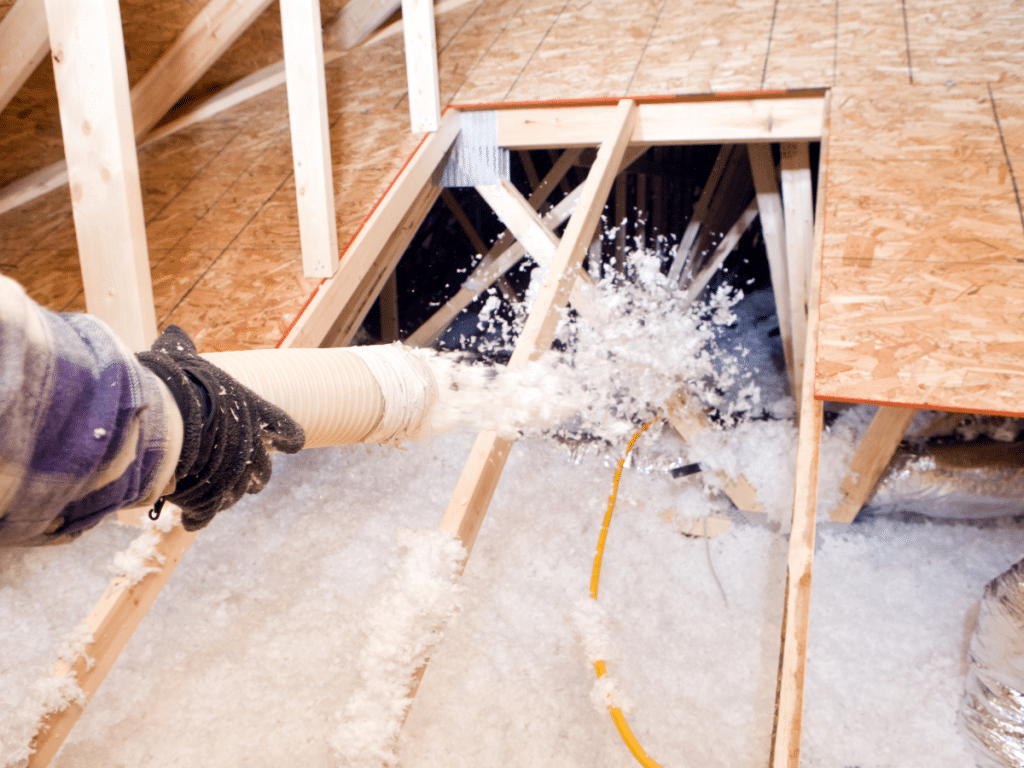If you’ve been researching ways to boost your home’s energy efficiency or make your indoor space more comfortable year-round, you’ve likely encountered the term blown-in insulation. But what exactly is it, how does it work, and is it the right choice for your home, especially if you live in places with extreme weather swings like Arizona?
In this guide, we’ll explain everything you need to know about blown-in insulation, including its materials, installation process, pros and cons, and cost. Whether you’re building new or upgrading your current insulation, this article will help you make an informed decision.
What Is Blown-In Insulation?
Blown-in insulation—also called loose-fill insulation—is a method of insulating your home using small, loose particles that are literally “blown” into spaces using a special blowing machine. Unlike traditional batts or rolls of insulation, blown-in insulation material conforms to whatever space it fills, making it ideal for attics, wall cavities, and hard-to-reach areas like crawl spaces.
This type of insulation can improve your home’s R-value, which measures how well a material resists heat flow. The higher the R-value, the better the insulation performs, keeping your home warmer in winter and cooler in summer.
How Does Blown-In Insulation Work?
To install blown-in insulation, technicians use a machine called an insulation blower. Here’s how it works:
- Loose insulation material (like cellulose or fiberglass) is fed into a hopper.
The machine churns and fluffs up the material, mixing it with air. - It is then blown through a hose into your attic floor or wall cavities.
- The insulation settles into the space like joists in your attic or walls, filling the gaps between the framing. This ensures even coverage and better heat retention, which also helps with air sealing.
Because of its flexibility, blown-in insulation is particularly effective in existing homes, where opening up walls might not be practical.
Types of Blown-In Insulation Materials
Not all blown-in insulation is created equal. Depending on your goals—whether it’s maximum energy savings, eco-friendliness, fire resistance, or cost-efficiency—you’ll want to choose the right material for your specific needs.
Here’s a breakdown of the most common types of blown-in insulation and what sets them apart:
1. Cellulose Insulation
Cellulose is one of the most widely used blown-in insulation materials, for good reason. It’s a smart, eco-friendly choice, made primarily from recycled materials like newspaper and treated with fire retardant and mold-resistant additives.
- Eco-conscious: 80–85% recycled content
- Safety treated: Resists fire, mold, and pests
- Versatile: Perfect for attics and enclosed wall cavities
- R-Value: Approximately 3.2 to 3.8 per inch
- Best for: Homeowners seeking an affordable, green option
Cellulose insulation is an excellent option for attic insulation, as it provides good coverage and efficiency in hard-to-reach spaces like attics.
2. Blown-In Fiberglass Insulation
Composed of ultra-fine glass fibers, blown-in fiberglass is a lightweight and budget-friendly option that performs well in dry climates, such as Arizona. While it’s similar in cost to cellulose, it may settle more over time, which can affect performance in certain applications.
- Affordable: Lower upfront cost
- Climate fit: Works well in hot, dry environments
- R-Value: Around 2.2 to 2.7 per inch
- Best for: Attic floors, especially where some settling is acceptable
Note: Watch for reduced effectiveness over time if not properly installed
3. Mineral Wool Insulation (Rock Wool)
Made from industrial slag or molten rock spun into fibers, mineral wool offers excellent thermal insulation, top-tier fire, and sound resistance. It’s heavier and more expensive than cellulose or fiberglass, but its durability and performance often justify the cost.
- Soundproofing: Great for noise reduction
- Fire-resistant: Handles high temperatures better than other materials
- R-Value: About 3.0 to 3.3 per inch
- Best for: Homes needing extra protection or noise control
Note: Contains some recycled content, but not biodegradable
4. Eco-Friendly Alternatives
If sustainability is a top priority, there are several biodegradable and renewable blown-in options worth considering. These include sheep’s wool, recycled cotton (often denim), cork granules, aerogel, and plant-based spray foams like icynene.
- Sustainable materials: Natural, non-toxic, and renewable
- Higher cost: Generally more expensive due to sourcing and processing
- R-Value: Varies by material (e.g., aerogel up to 10+ per inch)
Best for: Green homes and environmentally focused renovations
Note: Consider some products like aerogel are niche and may not be widely available
Now that you’re familiar with the different materials available, let’s weigh the pros and cons to see if blown-in insulation is the right fit for your home.
Pros and Cons of Blown-In Insulation: What to Expect
Before you decide whether blown-in insulation is right for your home, weigh the benefits against potential drawbacks. Every insulation material and method has trade-offs, and understanding them helps you make a more informed choice.
Pros
- Excellent coverage: Blown-in insulation fills every nook and cranny, making it ideal for oddly shaped or tight spaces.
- Fast installation: A professional team can insulate an entire attic or wall section in just a few hours.
- Boosts energy efficiency: Reduces heating and cooling costs year-round by improving your home’s R-value and limiting heat loss and heat transfer.
- Eco-friendly options: Materials like cellulose and wool are sustainable and non-toxic.
- Great for retrofits: Perfect for older homes where wall cavities are already closed off.
Cons
- Requires special equipment: Insulation installation is not DIY-friendly unless you have access to the right tools and experience.
- Moisture-sensitive: Some materials, especially cellulose, can retain moisture and promote mold growth if exposed to leaks.
- Settling over time: This can reduce R-value, particularly with fiberglass.
- Wall installation leaves plugs: Small holes are drilled to inject insulation, which are then sealed with plastic caps that may be visible on some surfaces.
Blown-in insulation offers excellent coverage, but it’s essential to consider how it compares to other insulation types. For example, spray foam insulation is another popular choice, but its cost and installation process differ significantly. Comparing these options—like spray foam vs. blown-in insulation—can help you determine the best fit for your home.
Best Applications for Blown-In Insulation: Why It Works So Well in Attics and Walls
When it comes to improving your home’s insulation, blown-in insulation shines in specific areas—particularly attics and existing wall cavities. Here’s why:
1. Attic Insulation
Blown-in insulation is one of the most effective ways to insulate your attic. It covers the floor like a thick blanket, helping to trap indoor air and reduce heat gain during Arizona’s scorching summers. It can also be layered over existing fiberglass batts to boost your home’s overall thermal performance without removing the old material.
Benefits of attic application:
- Quick and clean installation
- Fills gaps around pipes, wires, and beams
- Boosts HVAC efficiency and reduces strain on your system
2. Wall Cavity Insulation
If your home has older walls without proper insulation, blown-in insulation is often the only practical retrofit solution. Instead of tearing down drywall or exterior siding, small holes are drilled to blow insulation directly into wall cavities. Once filled, the holes are plugged and can be patched or painted.
Benefits of wall cavity insulation:
- Increases comfort without major remodeling
- Cuts down on drafts and cold spots
- Helps with soundproofing between rooms
Note: In older homes, wall cavities may contain obstructions like wiring or fire blocks. A skilled installer will know how to navigate around these to ensure complete coverage.
Cost of Blown-In Insulation
One of the most common follow-up questions to “What is blown-in insulation?” is, “How much will it cost me?”
Average Costs in Arizona
In Arizona, the cost of blown-in insulation ranges from $0.60 to $2.30 per square foot, depending on the material used:
| Material | Average Cost per Sq. Ft. |
| Fiberglass | $0.50 – $1.10 |
| Cellulose | $0.60 – $2.30 |
| Rock Wool | $1.40 – $2.10 |
| Sheep’s Wool | $1.50 – $3.10 |
Attic insulation for a 1,000 sq. ft. home may cost between $600 and $1,200. Wall insulation could add to that, depending on labor and access.
The effectiveness of your attic insulation can vary depending on the material you choose. Understanding what constitutes the best attic insulation for your home can help ensure you’re investing in the right solution for long-term energy savings.
Though the upfront cost may seem steep, blown-in insulation pays off by lowering your energy bills and helping your HVAC system run more efficiently—especially in Arizona’s scorching heat.
Should You Install Blown-In Insulation By Yourself?
While renting an insulation blower and installing it yourself is technically possible, especially for attic spaces, professional installation is strongly recommended. A trained HVAC or insulation contractor will:
- Know how to handle different materials properly.
- Ensure even coverage and correct depth.
- Identify and avoid wiring, ducts, or structural obstructions.
- Prevent costly mistakes that could affect insulation performance or safety.
Final Thoughts: Is Blown-In Insulation Right for You?
Blown-in insulation is an efficient, affordable way to improve your home’s comfort and lower energy bills—especially in Arizona’s extreme climate. It’s a smart solution for attics, wall cavities, and other hard-to-reach areas. Whether you’re dealing with uneven attic temperatures, cold spots in winter, or rising energy bills, adding this type of insulation could be the upgrade your home needs.
At American Home, Water & Air, we’ve been helping Arizona homeowners with home improvement projects for over 35 years. Our expert technicians can assess your home’s insulation needs and recommend the best solution—no guesswork required.
Contact us today to schedule an insulation installation consultation or learn more about how we can help optimize your home’s energy efficiency—whether you’re upgrading your HVAC SEER unit or improving insulation in crawl spaces.











